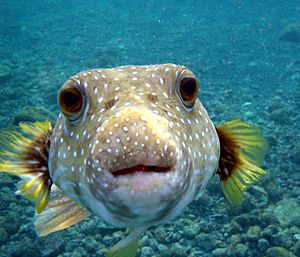Neurotoxin facts for kids

A neurotoxin is a special kind of poison that specifically harms your nerve cells. These nerve cells, called neurons, are like tiny wires that send messages all over your body, helping you move, think, and feel. Neurotoxins often work by messing with tiny parts of nerve cells called membrane proteins and ion channels, which are important for sending these messages.
Many animals use neurotoxins as venom to protect themselves or to catch food. When a neurotoxin enters the body, it can cause paralysis, which means you can't move your muscles. This can happen very quickly. For example, the venoms from bees, scorpions, pufferfish, spiders, and snakes often contain different types of neurotoxins. These toxins usually affect how nerve cells send electrical signals.
Contents
What are Neurotoxins?
Neurotoxins are chemicals that are harmful to the nervous system. The nervous system includes your brain, spinal cord, and all the nerves throughout your body. When neurotoxins attack, they can stop nerves from working correctly. This can lead to serious problems, like losing control of your muscles or even stopping your breathing.
How Neurotoxins Affect Nerves
Neurotoxins often target specific parts of nerve cells. Imagine a nerve cell as a tiny battery that sends electrical signals. These signals travel along the nerve like electricity through a wire. Neurotoxins can block these signals or make them fire too much.
For example, some neurotoxins block the tiny "doors" on nerve cells called ion channels. These doors control which chemicals can enter or leave the cell. If these doors are blocked, the nerve cell can't send its message. Other neurotoxins might force these doors open, making the nerve cell send too many messages, which can also be harmful.
Where are Neurotoxins Found?
Neurotoxins are found in many different places, both in nature and sometimes in things we use every day.
Neurotoxins in Animals
Many animals use neurotoxins as a defense mechanism or to hunt.
- Snakes and Spiders: Many snakes and spiders have venom that contains neurotoxins. When they bite, these toxins can quickly paralyze their prey or attacker.
- Scorpions and Bees: The sting of a scorpion or a bee also contains neurotoxins. While a bee sting might just be painful for humans, it can be very dangerous for smaller animals.
- Pufferfish: The pufferfish is famous for a powerful neurotoxin called tetrodotoxin. Even a tiny amount of this toxin can be deadly if eaten.
Neurotoxins in Nature
Neurotoxins can also be produced by very small organisms.
- Cyanobacteria: Some types of cyanobacteria, also known as blue-green algae, can produce neurotoxins. These are often found in algal blooms in lakes or ponds. If animals or humans drink water with these toxins, it can be very dangerous.
- Plants: A few plants also produce neurotoxins, though this is less common than in animals.
Other Sources of Neurotoxins
Sometimes, neurotoxins can come from human activities or the environment.
- Heavy Metals: Metals like lead can act as neurotoxins if they get into the body. This is why old lead pipes for water are dangerous. Lead can harm the developing brains of children.
- Pesticides: Some chemicals used to kill insects on farms can also be neurotoxins. This is why it's important to handle them carefully.
How the Body Protects Itself
Your body has ways to protect your brain from harmful substances, including neurotoxins.
- Blood-Brain Barrier: Your brain has a special shield called the blood-brain barrier. It's like a very strict security guard that decides what can enter the brain from your blood. This barrier helps keep many harmful chemicals, including some neurotoxins, from reaching your delicate brain cells.
- Astrocytes: Special cells called astrocytes are part of this barrier. They wrap around blood vessels in the brain, helping to control what gets through.
Even with these protections, very strong neurotoxins can sometimes get past the defenses and cause harm. This is why it's important to be careful around things that might contain these dangerous substances.
Images for kids
-
Neurotoxins can be found in some types of cyanobacteria, which can form green scum in algal blooms.
See also
 In Spanish: Neurotoxina para niños
In Spanish: Neurotoxina para niños






